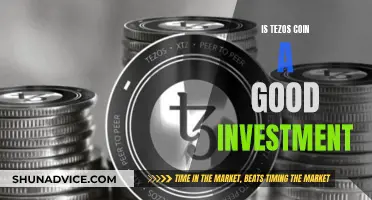
Stablecoins are a type of cryptocurrency designed to maintain a fixed value over time, usually pegged to a specific real currency, such as the US dollar. Unlike highly volatile cryptocurrencies like Bitcoin, stablecoins are backed by reserve assets such as gold or government-issued fiat currency, which makes their price more stable and less susceptible to market conditions. They are often used for quick and cheap payments or money transfers on a global scale, as well as in smart contracts, due to their stability. While stablecoins can be a good investment option for those who want to get involved with cryptocurrency but can't stomach the volatility, it's important to note that they are not completely risk-free and are subject to regulatory scrutiny.
| Characteristics | Values |
|---|---|
| Definition | A type of cryptocurrency designed to maintain a fixed value over time |
| Value Pegged To | A specific real currency (often the US dollar), commodities, gold, or other cryptocurrencies |
| Examples | Tether (USDT), USD Coin (USDC), DAI |
| Volatility | Less volatile than other cryptocurrencies, but still subject to some typical crypto risks |
| Backing | Reserve assets such as fiat currency, gold, or other cryptocurrencies |
| Use Cases | Quick and cheap payments, money transfers, staking, lending |
| Advantages | Stability, fast and accessible transactions, ease of use across exchanges |
| Disadvantages | Regulatory uncertainty, counterparty risk, reserve risk, lack of confidence |
What You'll Learn

Stablecoins are a type of cryptocurrency
Stablecoins are typically divided into three types: fiat-collateralized, crypto-collateralized, and non-collateralized (algorithmic). Fiat-collateralized stablecoins maintain a reserve of a fiat currency, such as the US dollar, as collateral. Crypto-collateralized stablecoins are backed by other cryptocurrencies, and because the reserve cryptocurrency may be prone to high volatility, such stablecoins are generally over-collateralized. Non-collateralized (or algorithmic) stablecoins use software algorithms to automatically adjust the supply of the stablecoin based on demand, aiming to maintain a stable price.
Stablecoins are important because they play a crucial role in the cryptocurrency ecosystem. They provide the speed and security features of a blockchain while eliminating the volatility that most cryptocurrencies endure. This makes them suitable for common transactions and they can even be used to pay for goods and services.
BTS Coin: A Smart Investment Move?
You may want to see also

They are designed to maintain a fixed value
Stablecoins are a type of cryptocurrency that is designed to maintain a fixed value over time. They are designed to be less volatile than other cryptocurrencies, making them more useful as a medium of exchange. The value of a stablecoin is typically pegged to a specific real currency, often the US dollar, with one unit of the cryptocurrency equalling one unit of the real currency. This is known as a 1:1 backing or peg.
Stablecoins are "pegged" or "backed" by being linked to an underlying asset, such as a fiat currency, or a precious metal like gold. The underlying asset acts as collateral, and the stablecoin is "backed" by being connected to a reserve of the underlying asset. For example, a stablecoin could hold $100 million in reserve and issue 100 million coins with a fixed value of $1 per coin. If a stablecoin owner wants to cash out, the real money can be taken from the reserve. This is known as being "fiat-backed" or "fiat-collateralized".
Other stablecoins are backed by other cryptocurrencies, or by commodities like gold or silver. These are known as "crypto-backed" or "crypto-collateralized" and "commodity-backed" respectively.
Stablecoins can also be algorithmic, meaning they are not backed by any asset, but instead use algorithms to control the supply of the stablecoin, increasing or decreasing it to maintain the fixed value.
Bitcoin vs Gold: The Future of Investment Portfolios
You may want to see also

Stablecoins are less volatile than other cryptocurrencies
Stablecoins are often backed by hard assets like fiat currencies, precious metals, or commodities, which help to stabilise their value. For example, a stablecoin could hold $100 million in reserve and issue 100 million coins with a fixed value of $1 per coin. If the owner wants to cash out the coin, the real money can be taken from the reserve.
Stablecoins can also be algorithmic, using technical means to maintain their value, such as destroying some of the coin supply to create scarcity. However, these are considered riskier than asset-backed stablecoins.
The stability of stablecoins makes them more useful as a store of value and medium of exchange, and they are often used for quick and cheap payments or money transfers on a global scale. They are also used within crypto brokerages and with smart contracts.
While stablecoins are less volatile than other cryptocurrencies, they are not without risk. These include security risks, counterparty risks, reserve risks, and a lack of confidence if the stablecoin is not sufficiently backed by hard assets.
The Ultimate Guide to Solo Bitcoin Investing
You may want to see also

They are backed by reserve assets
Stablecoins are cryptocurrencies that are pegged to the value of a reserve asset, such as a fiat currency, a commodity, or another cryptocurrency. This means that for every unit of the stablecoin, there is a corresponding unit of the reserve asset held in a reserve. For example, the stablecoin Tether (USDT) is pegged to the US dollar at a 1:1 ratio, meaning that for every 1 USDT, there is 1 US dollar held in reserve.
The use of reserve assets to back the value of stablecoins is intended to maintain price stability and reduce volatility, which is a common issue with cryptocurrencies such as Bitcoin and Ethereum. By being backed by reserve assets, stablecoins can provide more stability and trust compared to other cryptocurrencies, making them more suitable for everyday transactions and payments.
There are different types of stablecoins based on the assets used to back their value:
- Fiat-backed stablecoins: These stablecoins are backed by fiat currencies such as the US dollar, euro, or Swiss franc. The value of the stablecoin is pegged to the value of the fiat currency on a 1:1 basis. Examples include Tether (USDT) and USD Coin (USDC).
- Commodity-backed stablecoins: These stablecoins are backed by commodities such as precious metals (e.g., gold, silver) or industrial metals (e.g., oil). The value of the stablecoin is linked to the market price of the commodity. Tether Gold (XAUt) is an example of a commodity-backed stablecoin, where each token is backed by gold reserves.
- Crypto-backed stablecoins: These stablecoins are backed by other cryptocurrencies as collateral. Due to the volatile nature of cryptocurrencies, crypto-backed stablecoins are often over-collateralized, meaning the value of the cryptocurrency held in reserve exceeds the value of the stablecoins issued. For instance, MakerDAO's Dai (DAI) stablecoin is pegged to the US dollar but is backed by Ethereum (ETH) and other cryptocurrencies worth more than the DAI stablecoin in circulation.
While stablecoins aim to provide stability by being backed by reserve assets, it is important to note that they are not without risks. The stability of stablecoins relies on the trustworthiness and transparency of the issuing institution and the custodian of the reserve assets. Additionally, stablecoins can be subject to the same volatility and risks associated with the backing asset. Furthermore, there have been concerns and incidents regarding the adequacy of reserves and the accuracy of reporting by some stablecoin issuers, highlighting the importance of independent audits and regulatory oversight.
Coinbase Company Investment: Registering Your Business Interest
You may want to see also

You can buy stablecoins on a crypto exchange
Stablecoins are a type of cryptocurrency that is designed to maintain a fixed value over time. They are less volatile than other cryptocurrencies, making them a good option for investors who are wary of the drastic price swings that can occur in the crypto market. The value of a stablecoin is typically pegged 1:1 to a specific real currency, often the US dollar.
Decide which stablecoin you want to buy
First, you need to figure out the type of stablecoin you want to purchase. Most stablecoins follow the US dollar, but there are also stablecoins tied to other assets, such as gold or even other cryptocurrencies. Examples of stablecoins pegged to the US dollar include USD Coin, the Gemini dollar, and Binance USD.
Pick a secure crypto exchange
When choosing a crypto exchange, you have two options:
- Find an exchange that sells the specific stablecoin you want.
- Find an exchange you like and then buy whichever stablecoin it offers.
Almost all major exchanges offer at least one stablecoin that follows the US dollar. Some of the best cryptocurrency exchanges have their own US dollar stablecoins. Examples include Coinbase, Gemini, and Binance.
Sign up with the crypto exchange
The exact registration process will depend on the exchange, but it is usually straightforward. You may need to provide the following information to create an account:
- Your name
- Your email address
- Your Social Security number
- A scan of a valid ID document, such as your driver's license or passport
Verify your identity
During or after creating your account, you will need to go through an identity verification process. Exchanges require this to ensure that accounts are not being used for illegal activities and to comply with tax reporting requirements.
Load money into your exchange account
You will need to add funds to your exchange account so that you can buy crypto. The recommended way to do this is by transferring money from your bank account. You can add your bank account as a funding source using the account number and routing number. Keep in mind that it can take several business days for the transfer to process.
You may also be able to buy crypto using other methods, such as debit cards, credit cards, or PayPal, but these methods usually carry additional fees.
Buy the stablecoin
Once your account is funded, choose the option to buy crypto. Depending on the exchange, there may be a "Buy" button or page. Select the stablecoin you want to purchase and the amount you would like to spend. You will then be able to review the transaction details, including the fees, total cost, and how much of the stablecoin you will receive. When you are ready, confirm the purchase.
Stablecoin purchases usually don't take long, so your coins should be available in your account quickly. At that point, you can use your stablecoins however you like, whether that's lending them, transferring them to someone else, or storing them in a crypto wallet.
The Basics of Bitcoin Investment Explained
You may want to see also
Frequently asked questions
Stablecoins are a type of cryptocurrency that is designed to maintain a fixed value over time. They are backed by reserve assets such as the US dollar, gold, or other cryptocurrencies, which helps to stabilise their price.
The value of most cryptocurrencies is largely determined by market forces and speculation, leading to high volatility. Stablecoins, on the other hand, are designed to be stable and are not subject to the same level of volatility as they are pegged to the value of a stable asset.
While stablecoins are less risky than other cryptocurrencies, they still carry some typical crypto risks. These include security risks, counterparty risks, and reserve risks. Additionally, stablecoins that are not sufficiently backed by hard assets may suffer a loss of confidence and a run on the coin, as seen with the algorithmic stablecoin TerraUSD in May 2022.
You can buy stablecoins through a crypto exchange or a digital wallet where you can purchase crypto directly. Popular exchanges include Coinbase and WazirX.
Stablecoins may be a good option for those who want to get involved with cryptocurrency but are wary of its volatility. However, it is important to note that stablecoins are designed to be stable, so don't expect explosive gains. You can earn interest on stablecoins by holding them for the long term, or through lending and staking.







